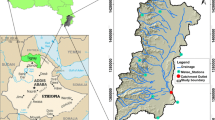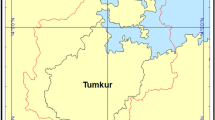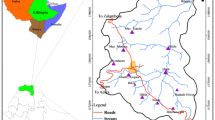Abstract
Improvement in modern water resource management has become increasingly reliant on better characterizing of the spatial variability of groundwater recharge mechanisms. Due to the flexibility and reliability of GIS-based index models, they have become an alternative for mapping and interpreting recharge systems. For this reason, an index model by integrating water balance parameters (surface runoff, actual evapotranspiration, and percolation) calculated by Thornthwaite and Mather’s method, with maps of soil texture, land cover, and terrain slope, was developed for a sustainable use of the groundwater resources. The Serra de Santa Helena Environmental Protection Area, next to the urbanized area of Sete Lagoas (MG), Brazil, was selected as the study area. Rapid economic growth has led to the subsequent expansion of the nearby urban area. Large variability in soil type, land use, and slope in this region resulted in spatially complex relationships between recharge areas. Due to these conditions, the study area was divided into four zones, according to the amount of recharge: high (> 100 mm/year), moderate (50–100 mm/year), low (25–50 mm/year), and incipient (> 25 mm/year). The technique proved to be a viable method to estimate the spatial variability of recharge, especially in areas with little to no in situ data. The success of the tool indicates it can be used for a variety of groundwater resource management applications.







Similar content being viewed by others
References
Allen PA (1997) Earth surface processes. Blackwell Sciences, Oxford, 404 p
Andreo B, Vías JM, Durán JJ, Jiménez P, López-Geta JA, Carrasco F (2008) Methodology for groundwater recharge assessment in carbonate aquifers: application to pilot sites in southern Spain. Hydrogeol J 16:911–925
ASCE—American Society of Civil Engineers (1969) Task force on effect of urban development on flood discharges, committee on flood control, “effect of urban development on flood discharges—current knowledge and future needs”, J Hydraul Division, 95 (HY1), 287–309
Batelaan O, De Smedt F (2007) GIS-based recharge estimation by coupling surface-subsurface water balances. J Hydrol 337:337–355
Birkle P, Torres Rodríguez V, González Partida E (1998) The water balance for the basin of the valley of Mexico and implications for future water consumption. Hydrogeol J 6(4):500–517
Blavoux B, Mudry J, Puig JM (1992) Budget, functioning and protection of Fontaine de Vaucluse system (south-east France) (in French). Geodin Acta 5(3):153–172
Branco Jr, Costa MT (1961) Belo Horizonte-Brasilia road map tour. Brazilian Congress of Geology, Brasilia. Radioactive Research Institute, Federal University of Minas Gerais (UFMG), Publication 15, Belo Horizonte, p 25
Charman PEV, Murphy BW (2000) Soils: their properties and management, 2nd edn. Oxford University Press, Melbourne, 448p
Chenini I, Benmammou A, Elmay M (2010) Groundwater recharge zone mapping using GIS-based multi-criteria analysis: a case study in central Tunisia (Maknassy Basin). Int J Water Resour Manag 24:921–939
Cherkauer DS (2004) Quantifying ground water recharge at multiple scales using PRMS and GIS, Ground Water, vol 42, 1, pp 97–110
Coutagne A (1954) Study of some regional hydrometereological correlations and their algebraic interpretation (in French)
Custodio E, Llamas MR (2001) Hidrologia subterrânea. Tomo I e II, Ediciones Omega. S.A, Barcelona. 2350p
Dardene MA (1978) Synthesis on the stratigraphy of Bambuí Group in Central Brazil. Brazilian Congress of Geology, 30, Recife. Annals Recife: Brazilian Society of Geology, 1978 v.2, pp 597–610
Das MM, Saikia MD (2013) Watershed management. PHI Learning Private Limited. 303p
Dripps W, Bradbury K (2007) A simple, daily soil–water balance model for estimating the spatial and temporal distribution of ground water recharge in temperate humid areas. Hydrogeol J 15(3):433–444
Dripps W, Bradbury K (2009) The spatial and temporal variability of ground water recharge in a forested basin in Northern Wisconsin. Hydrol Process 24(4):383–392
Feitosa FAC (2008) Hidrogeologia: conceitos e aplicações [Hydrogeology: concepts and aplications, 3rd edn. CPRM, Rio de Janeiro, 812p LABHID.
Fenn DG, Hanley KJ, De Geare TV (1975) Use of the Water Balance Method for predicting leachate generation from solid waste disposal sites. US Environmental Protection Agency, Report No. EPA/530/SW168
Fetter CW (1994) Applied hydrogeology, 616. Macmillan College Publishing, Inc., New York
Flint AL, Flint LE, Kwicklis EM, Fabryka-Martin JT, Bodvarsson GS (2002) Estimating recharge at Yucca Mountain, Nevada, USA: comparison of methods. Hydrogeol J 10(1):180–204
Freeze AR, Cherry JA (1979) Groundwater: Englewood Cliffs, New Jersey, Prentice-Hall, 604
Galvão P, Halihan T, Hirata R (2015a) The Karst Permeability Scale Effect of Sete Lagoas, MG, Brazil. J Hydrol 531:85/15–105. https://doi.org/10.1016/j.jhydrol.2015.11.026
Galvão P, Halihan T, Hirata R (2015b) Evaluating karst geotechnical risk in the urbanized area of Sete Lagoas, Minas Gerais, Brazil. Hydrogeol J 23(7):1499–1513
Galvão P, Hirata R, Cordeiro A, Osório DB, Peñaranda J (2016) Geologic conceptual model of the municipality of Sete Lagoas (MG, Brazil) and the surroundings. Anais da Academia Brasileira de Ciências 88(1):35–53
Galvão P, Halihan T, Hirata R (2017a) Transmissivity of aquifer by capture zone method: an application in the Sete Lagoas Karst Aquifer, MG, Brazil. Anais da Academia Brasileira de Ciências, v. 89, pp 91–102
Galvão P, Hirata R, Halihan T, Terada R (2017b) Recharge sources and hydrochemical evolution of an urban karst aquifer, Sete Lagoas, MG, Brazil. Environ Earth Sci 76:159. https://doi.org/10.1007/s12665-017-6482-3
Healy RW (2010) Estimating groundwater recharge. Cambridge University Press, Cambridge, 264
Heathcote JA, Lewis RT, Soley RWN (2004) Rainfall routing to runoff and recharge for regional groundwater resource models. Q J Eng Geol Hydrogeol 37(2):113–130
Jasrotia AS, Kumar R, Saraf AK (2007) Delineation of groundwater recharge sites using integrated remote sensing and GIS in Jammu district, India. Int J Remote Sens 28(22):5019–5036
Jocson JMU, Jenson JW, Contractor DN (2002) Recharge and aquifer response: northern Guam Lens Aquifer, Guam Mariana Islands. J Hydrol 260:231–254
Koerner RM, Daniel DE (1997) Final covers for solid waste landfills and abandoned dumps. ASCE Press, Reston, 256 p
Leeper GW, Uren NC (1993) Soil science: an introduction, 5th edn. Melbourne University Press, Melbourne, 312p
Lerner DN, Issar AS, Simmers I (1990) Groundwater recharge: a guide to understanding and estimating natural recharge. International Contributions to Hydrogeology 8. Heise, Hannover
Lin Y-F, Anderson MP (2003) A digital procedure for ground water recharge and discharge pattern recognition and rate estimation. ground water, vol 41, 3, pp 306–315
Murphy EM, Ginn TR, Phillips JL (1996) Geochemical estimates of palaeo recharge in the Pasco Basin: evolution of the chloride mass balance technique. Water Resour Res 32(9):2853–2868
Nag SK (2005) Application of lineament density and hydrogeomorphology to delineate groundwater potential zones of Baghmundi block in Purulia district, West Bengal. J Indian Soc Rem Sens 33(4):522–529
Nolan BT, Healy RV, Taber PE, Perkins K, Hitt KJ, Wolock DM (2006) Factors influencing ground-water recharge in the eastern United States. J Hydrol 332(1–2):187–205. https://doi.org/10.1016/j.hydrol.2006.06.029
Oliveira MAM (1967) Contribution to the geology of the southern part of the São Francisco Basin and adjacent areas. Collection of Reports Exploration, Rio de Janeiro 1: Petrobras, n.3, pp 71–105
Pessoa P (1996) Hydrogeological characterization of the region of Sete Lagoas - MG: Potentials and Risks. Master Thesis. Department of Geosciences, University of São Paulo. São Paulo
Rashid M, Lone MA, Ahmed S (2012) Integrating geospatial and ground geophysical informationas guidelines for groundwater potential zones in hard rock terrains of south India. Environ Monit Assess 184:4829–4839. https://doi.org/10.1007/s10661-011-2305-2
Ribeiro JF, Walter BMT (2008) As principais fitofisionomias do Bioma Cerrado. In: Almeida SP, Ribeiro JF (eds) Cerrado: ecologia e flora [The main vegetation types of the Cerrado. In Cerrado: ecologyand flora]. SM Sano, Embrapa-CPAC, Planaltina, pp 151–212
Ribeiro JH, Tuller MP, Danderfer Filho A (2003) Geological mapping of the region of Sete Lagoas, Pedro Leopoldo, Matozinhos, Lagoa Santa, Vespasiano, Capim Branco, Prudente de Morais, Confins and Funilândia, Minas Gerais State, Brazil (scale1:50,000). 2nd edn. Belo Horizonte. 54 p
Rwanga SS, Ndambuki JM (2017) Approach to quantify groundwater recharge using gis based water balance model: a review. Int J Adv Agric Environ Eng (IJAAEE) 4:Issue 1
Samper J (1998) Evaluation of recharge from rainfall using water balances: utilization, calibration and uncertainties (in Spanish). Bol Geol Miner 109:347–370
Scanlon BR, Healy RW, Cook PG (2002) Choosing appropriate techniques for quantifying groundwater recharge. Hydrogeol J 10:18–39
Schobbenhaus C (1984) Geology of Brazil. National Department of Mineral Production, pp 275–277
Schöll WU, Fogaça ACC (1973) Stratigraphy of the Espinhaço in the Diamantina region. In: Symposium on Geology of Minas Gerais State, Brazil, 1. Acts. Belo Horizonte: Brazilian Geology Society p 55–73 [Bulletin. 1]
Schwartz FW, Zhang H (2003) Fundamentals of ground water. Wiley, New York
Sharma ML (1990) Groundwater recharge. Balkema, Rotterdam
Srivastava PK, Bhattacharya AK (2006) Groundwater assessment through an integrated approach using remote sensing, using remote sensing, GIS and resistivity techniques: a case study from a hard rock terrain. Int J Remote Sens 27(20):4599–4620
Sukhija BS, Nagabhushanam P, Reddy DV (1996) Groundwater recharge in semi-arid regions of India: an overview of results obtained using tracers. Hydrogeol J 4(3):50–71
Thornthwaite CW (1948) An approach towards a rational classification of climate. Geogr Rev 38:55–94
Thornthwaite CW, Mather JR (1955) The water balance. Publications in climatology. Laboratory of climatology. New Gersey 8:104
Tilahun K, Merkel BJ (2009) Estimation of groundwater recharge using a GIS-based distributed water balance model in Dire Dawa, Ethiopia Hydrogeol J 17:1443–1457. https://doi.org/10.1007/s10040-009-0455-x
Tucci CEM, Barros MT, Porto RL (1995) Drenagem Urbana. Ed., Porto Alegre, Universidade/UFRGS, 414 p
Tuller MP, Ribeiro JH, Signorelli N, Féboli WL, Pinho JMM (2010) Sete Lagoas—Abaeté Project, Minas Gerais State, Brazil. 6 geological maps, scale 1:100.000 (Geology Program of Brazil), 160p
Westenbroek SM, Kelson VA, Dripps WR, Hunt RJ, Bradbury KR, 2010. SWB—a modified thornthwaite-Mather Soil-Water-Balance Code for Estimating Groundwater Recharge: U.S. Geological Survey Techniques and Methods 6-A31, 60 p
Wood WW, Sanford WE (1995) Chemical and isotopic methods for quantifying groundwater recharge in a regional, semiarid environment. Ground Water 33:458–468
IBGE—Brazilian Institute of Geography and Statistics (2015) Basic Municipal Information.Available: http://www.cidades.ibge.gov.br/xtras/perfil.php?lang=&codmun=316720&search=minas-gerais|sete-lagoas. Accessed Oct 2016
Acknowledgements
This work was supported by Biopreservação Consultoria e Empreendimentos. Special thanks go to Gustavo Ganzaroli Mahé, Sidney Schaberle Goveia, and Kyle Spears.
Author information
Authors and Affiliations
Corresponding author
Rights and permissions
About this article
Cite this article
Galvão, P., Hirata, R. & Conicelli, B. Estimating groundwater recharge using GIS-based distributed water balance model in an environmental protection area in the city of Sete Lagoas (MG), Brazil. Environ Earth Sci 77, 398 (2018). https://doi.org/10.1007/s12665-018-7579-z
Received:
Accepted:
Published:
DOI: https://doi.org/10.1007/s12665-018-7579-z




